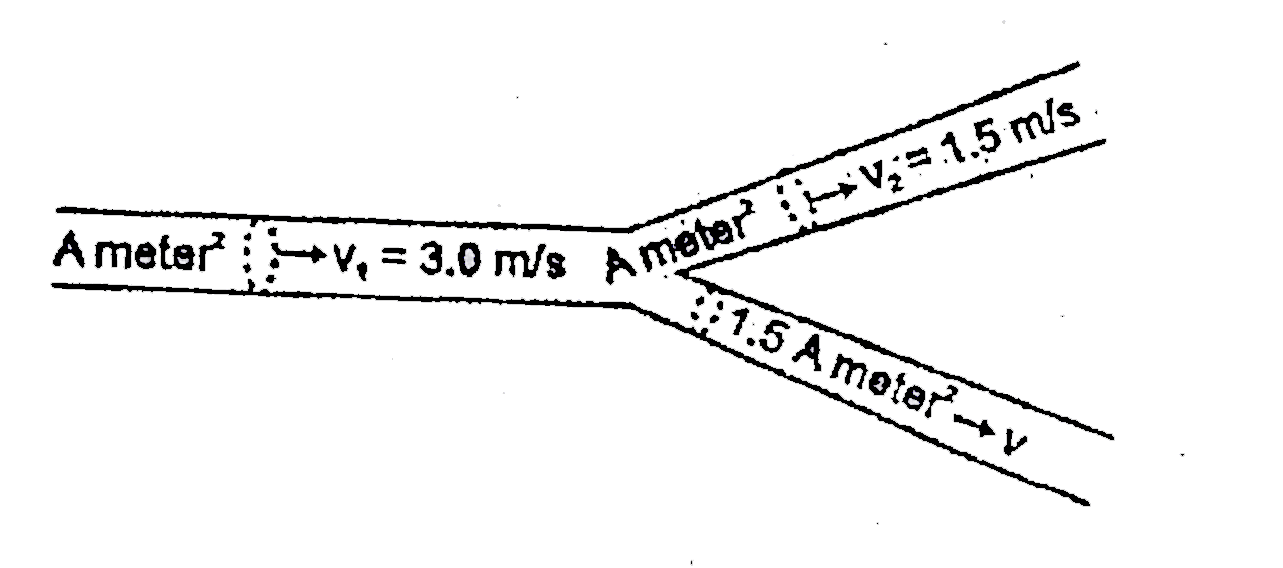A fluid is flowing through a tube of length L. The radius of the tube is r and the velocity of the fluid is v. If the radius of the tube is increased to 2r, then what will be the new velocity?
4v
v/4
v/2
2v
The correct Answer is:B
To find the new velocity of the fluid when the radius of the tube is increased from r to 2r, we can use the principle of conservation of mass, often referred to as the equation of continuity for fluids.
1. Understand the Equation of Continuity:
The equation of continuity states that the mass flow rate must remain constant in a steady flow. This can be expressed as:
A1v1=A2v2
where A1 and A2 are the cross-sectional areas at two points in the tube, and v1 and v2 are the fluid velocities at those points.
2. Calculate the Initial Area:
The initial radius of the tube is r. The cross-sectional area A1 can be calculated using the formula for the area of a circle:
A1=πr2
3. Calculate the New Area:
When the radius is increased to 2r, the new cross-sectional area A2 becomes:
A2=π(2r)2=π(4r2)=4πr2
4. Set Up the Equation:
According to the equation of continuity:
A1v1=A2v2
Substituting the areas and velocities:
(πr2)v=(4πr2)v′
5. Cancel Common Terms:
We can cancel πr2 from both sides of the equation:
v=4v′
6. Solve for the New Velocity:
Rearranging the equation to solve for v′:
v′=v4
Final Answer:
The new velocity v′ when the radius of the tube is increased to 2r is:
v′=v4
The equation of continuity states that the mass flow rate must remain constant in a steady flow. This can be expressed as:
A1v1=A2v2
where A1 and A2 are the cross-sectional areas at two points in the tube, and v1 and v2 are the fluid velocities at those points.
The initial radius of the tube is r. The cross-sectional area A1 can be calculated using the formula for the area of a circle:
A1=πr2
When the radius is increased to 2r, the new cross-sectional area A2 becomes:
A2=π(2r)2=π(4r2)=4πr2
According to the equation of continuity:
A1v1=A2v2
Substituting the areas and velocities:
(πr2)v=(4πr2)v′
We can cancel πr2 from both sides of the equation:
v=4v′
Rearranging the equation to solve for v′:
v′=v4
The new velocity v′ when the radius of the tube is increased to 2r is:
v′=v4
Topper's Solved these Questions
- BOOK - MTG-WBJEECHAPTER - BULK PROPERTIES OF MATTEREXERCISE - WB JEE WORKOUT (ONE OR MORE THAN ONE OPTION CORRECT TYPE )10videos
BULK PROPERTIES OF MATTER
- BOOK - MTG-WBJEECHAPTER - BULK PROPERTIES OF MATTEREXERCISE - WB JEE PREVIOUS YEARS QUESTIONS (SINGLE OPTION CORRECT TYPE)22videos
BULK PROPERTIES OF MATTER
- BOOK - MTG-WBJEECHAPTER - ATOMS MOLECULES AND CHEMICAL ARITHEMETIC EXERCISE - WB JEE PREVIOUS YEARS QUESTIONS CATEGORY 1: SINGLE OPTION CORRECT TYPE (1 MARK)3videos
ATOMS MOLECULES AND CHEMICAL ARITHEMETIC
- BOOK - MTG-WBJEECHAPTER - CURRENT ELECTRICITY EXERCISE - WB JEE PREVIOUS YEARS QUESTIONS21videos
CURRENT ELECTRICITY
Similar Questions
What happens when the velocity of the liquid flowing through a horizontal tube is gradually increased?
View SolutionWater is flowing through a horizontal tube of non-uniform cross-section. At a place, the radius of the tube is 1.0cm and the velocity of water is 2m/s. What will be the velocity of water where the radius of the pipe is 2.0cm?
View Solution
Knowledge Check
- Question 1 - Select One
In laminar flow of fluid, the velocity of the fluid in contact with the walls of the tube is
AmaximumBbetween 0 and maximumCequal to critical velocityDzero - Question 2 - Select One
An idel fluid is flowing in a tube of varying corss- section .At some point the radius of the tube is r and the velocity of flow is v .The velocity of flow at another point, where the radius is r/2 is :
Av/4Bv/2C2vD4v - Question 3 - Select One
Water is flowing through a horizontal tube of non uniform cross-section. At a place the radius of the rube is 0.5 cm and the velocity of water there is 20 cm/s. What will be the velocity at another place wehre the radius of the tube is 1.0 cm?
A3 cm/sB7 cm/sC5 cm/sD0.5 cm/s
A viscous fluid is flowing through a cylindrical tube. The velocity distribution of the fluid is best represented by the diagram
View SolutionTurpentine oil is flowing through a tube of length I and radius r. The pressure difference between the two ends of the tube is P , the visocity of oil at a distance x from the axis of tube from this relation, the dimensions of viscosity are :
View SolutionThe velocity of liquid flowing through a tube at certain distance from the axis of tube
View SolutionWater is flowing through a tube of radius r with a speed v. If this tube is joined to another tube of radius r/2, what is the speed of water in the second tube?
View SolutionAn incompressible liquid flows through a horizontal tube as shown in the figure. Then the velocity 'v' of the fluid is:
 View Solution
View Solution

